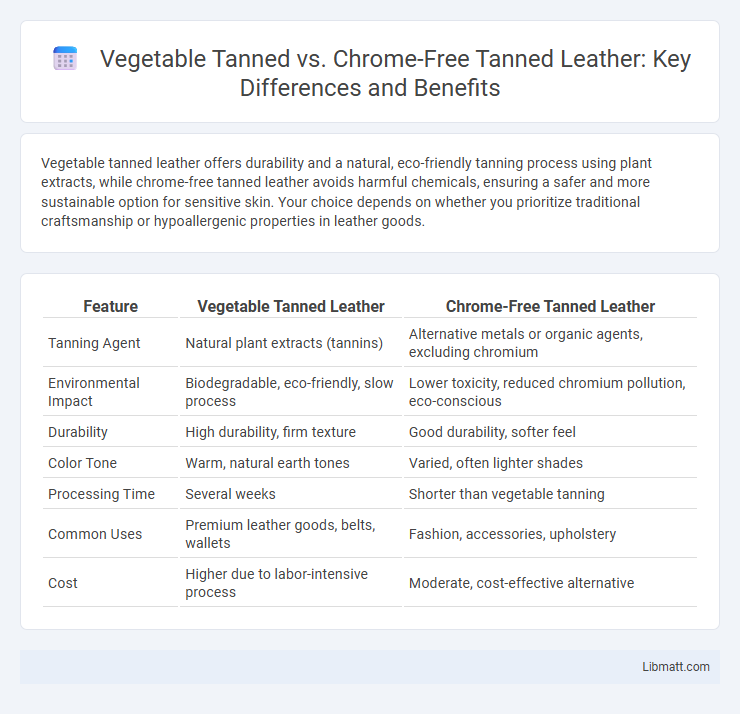Vegetable tanned leather offers durability and a natural, eco-friendly tanning process using plant extracts, while chrome-free tanned leather avoids harmful chemicals, ensuring a safer and more sustainable option for sensitive skin. Your choice depends on whether you prioritize traditional craftsmanship or hypoallergenic properties in leather goods.
Table of Comparison
| Feature | Vegetable Tanned Leather | Chrome-Free Tanned Leather |
|---|---|---|
| Tanning Agent | Natural plant extracts (tannins) | Alternative metals or organic agents, excluding chromium |
| Environmental Impact | Biodegradable, eco-friendly, slow process | Lower toxicity, reduced chromium pollution, eco-conscious |
| Durability | High durability, firm texture | Good durability, softer feel |
| Color Tone | Warm, natural earth tones | Varied, often lighter shades |
| Processing Time | Several weeks | Shorter than vegetable tanning |
| Common Uses | Premium leather goods, belts, wallets | Fashion, accessories, upholstery |
| Cost | Higher due to labor-intensive process | Moderate, cost-effective alternative |
Introduction to Leather Tanning Methods
Vegetable tanned leather utilizes natural tannins from tree bark and plant extracts, producing durable and eco-friendly leather with a distinctive aroma and rich patina over time. Chrome-free tanning avoids chromium salts, reducing environmental pollution and health risks, while offering softer, more supple leather favored in sustainable fashion. Both methods prioritize different ecological benefits and aesthetic qualities, influencing leather's texture, longevity, and environmental impact in the industry.
What Is Vegetable Tanned Leather?
Vegetable tanned leather is crafted using natural tannins extracted from tree bark, leaves, and other plant materials, resulting in a durable, eco-friendly product with a rich, natural patina that develops over time. This traditional tanning method avoids harmful chemicals found in chrome-free tanning, making it a sustainable choice for high-quality leather goods. Understanding your choice between vegetable tanned and chrome-free tanned leather helps ensure you select materials that align with your values for longevity and environmental impact.
What Does Chrome-Free Tanned Mean?
Chrome-free tanned leather is processed without using chromium salts, relying instead on natural tannins derived from plant sources like bark, leaves, and fruits. This method results in leather that is more environmentally friendly, biodegradable, and often preferred for its chemical-free composition, which can be gentler on your skin. Unlike traditional chrome-tanned leather, chrome-free tanned leather avoids heavy metal contaminants, making it a safer choice for those seeking sustainable and non-toxic leather products.
Tanning Process: Vegetable vs Chrome-Free
Vegetable tanning uses natural tannins from tree bark and plants, producing durable, eco-friendly leather with rich, earthy tones. Chrome-free tanning eliminates harmful chromium salts, relying on alternative agents like aldehydes or synthetic tannins, resulting in softer, hypoallergenic leather. Your choice depends on desired environmental impact and leather characteristics, with vegetable tanning favoring traditional methods and chrome-free processes offering greener, modern alternatives.
Environmental Impact Comparison
Vegetable tanned leather uses natural tannins from plant sources like tree bark, resulting in a biodegradable and less chemically intensive process that reduces water pollution compared to chrome-free tanned leather, which may still involve synthetic chemicals for tanning without chromium compounds. Vegetable tanning typically requires longer processing times but offers a more sustainable option with lower toxic waste output, while chrome-free tanning aims to eliminate heavy metals but can vary widely in environmental friendliness depending on alternative chemicals used. Overall, vegetable tanned leather presents a more eco-friendly lifecycle by relying on renewable resources and minimizing chemical hazards.
Durability and Longevity
Vegetable-tanned leather, treated with natural tannins from tree bark, offers superior durability and develops a rich patina over time, enhancing its longevity. Chrome-free tanned leather avoids harmful chemicals while maintaining resilience, though it may soften faster and show wear sooner compared to traditional chrome-tanned options. Both tanning processes yield long-lasting leather products, but vegetable tanning is especially prized for its extended lifespan and robust texture.
Aesthetics and Texture Differences
Vegetable tanned leather features a rich, natural patina that deepens over time, offering a firm texture with a slightly rougher surface compared to chrome-free tanned leather. Chrome-free tanned leather tends to be softer and more supple, often showcasing a smoother and more consistent finish due to the absence of chrome salts. The aesthetic appeal of vegetable tanned leather lies in its organic, earthy tones and unique marks, while chrome-free tanned leather offers a more uniform look with enhanced flexibility.
Cost and Market Availability
Vegetable tanned leather generally costs more due to its lengthy natural tanning process and limited production scale, whereas chrome-free tanned leather tends to be more affordable and widely available because of faster chemical tanning methods. Market availability favors chrome-free options since they dominate industrial leather markets, while vegetable tanned leather is often found boutique or specialty goods. Consumer demand for eco-friendly and premium quality products is driving gradual growth in the vegetable tanned leather segment despite higher prices.
Best Uses for Each Leather Type
Vegetable tanned leather is ideal for products requiring durability and natural aging, such as belts, wallets, and saddles, as it develops a rich patina over time. Chrome-free tanned leather, often known for its eco-friendly processing and softness, suits sensitive items like gloves, luxury handbags, and footwear that benefit from flexible, breathable material. Your choice depends on whether you prioritize sustainability and comfort or long-lasting toughness and character development.
Choosing the Right Leather for Your Needs
Vegetable tanned leather offers durability, natural aging, and eco-friendly processing, making it ideal for those seeking sustainable and long-lasting products. Chrome-free tanned leather, free from harmful chemicals, ensures a safer, hypoallergenic option ideal for sensitive skin and environmentally conscious users. Your choice depends on preferences for environmental impact, leather longevity, and skin sensitivity.
Vegetable tanned vs chrome free tanned Infographic

 libmatt.com
libmatt.com